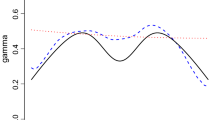Abstract
One of the issues contributing to the success of any extreme value modeling is the choice of the number of upper order statistics used for inference, or equivalently, the selection of an appropriate threshold. In this paper we propose a Bayesian predictive approach to the peaks over threshold method with the purpose of estimating extreme quantiles beyond the range of the data. In the peaks over threshold (POT) method, we assume that the threshold identifies a model with a specified prior probability, from a set of possible models. For each model, the predictive distribution of a future excess over the corresponding threshold is computed, as well as a conditional estimate for the corresponding tail probability. The unconditional tail probability for a given future extreme observation from the unknown distribution is then obtained as an average of the conditional tail estimates with weights given by the posterior probability of each model.
Similar content being viewed by others
References
Behrens, C.N.A., Lopes, H., and Gamerman, D., “Bayesian analysis of extreme events with threshold estimation.” Technical report. Department of Statistical Methods—Federal University of Rio de Janeiro, 2002.
Beirlant, J., Teugels, J.L., and Vynckier, P., Practical Analysis of Extreme Values, Leuven University Press, 1996a.
Beirlant, J., Vynckier, P., and Teugels, J.L., “Excess functions and estimation of the extreme-value index,” Bernoulli 2(4), 293–318, (1996b).
Best, N., Cowles, M.K., and Vines, K., “CODA convergence diagnosis and output software for gibbs sampling output,” Version 0.30, 1995.
Bermudez, P. de Zea and Amaral Turkman, M.A., “Bayesian approach to parameter estimation of the generalized pareto distribution.” Technical Research Report No: 7/2001, CEAUL/University of Lisbon (submitted to TEST), 2001.
Carroll, R.J., Chen, R., George, E.I., Li, T.H., Newton, H.J., Schmiediche, H., and Wang, N., “Ozone exposure and population density in Harris County, Texas.” Journal of the American Statistical Association 92(438), 392–404, (1997).
Cohen, J., “Penultimate form of approximation to normal extremes,” Adv. in Appl. Prob, 14, 324–339, (1982).
Davison, A.C. and Smith, R.L., “Models for exceedances over high thresholds,” J. R. Statist. Soc. B 52, 393–442, (1990).
de Haan, L., “Fighting the arch-enemy with mathematics,” Statistica Neerlandica 44, 45–48, (1990).
Dijk, V. and de Haan, L., “On the estimation of exceedance probability of a high level.” In: Order Statistics and Nonparametrics: Theory and Applications (P.K. Sen and I.A. Salam, eds), Elsevier, Amsterdam, 1992.
DuMouchel, W.H., “Estimating the stable index α in order to measure tail thickness: a critique,” The Annals of Statistics 11(4), 1019–1031, (1983).
Gomes, M.I., “Penultimate limiting forms in extreme value theory,” An Inst Ma., 36, 71–85, (1984).
Guttorp, P., Meiring, W., and Sampson, P., Comment on Carroll, R.J., Chen, R., George, E.I., Li, T.H., Newton, H.J., Schmiediche, H., and Wang, N., “Ozone exposure and population density in Harris County, Texas,” Journal of the American Statistical Association 92(438), 405–408, (1997).
Hasofer, A.M. and Wang, Z., “A test for extreme value domain of attraction,” Journal of the American Statistical Association 87, 171–177, (1992).
Hill, B.M., “A simple general approach to inference about the tail of a distribution,” The Annals of Statistics 3, 1163–1174, (1975).
Hsing, T., “A case study of ozone pollution with Xtremes,” In: Statistical Analysis of Extreme Values (Reiss, R.-D. and Thomas, M., eds), Kirkhäuser, 1997.
Hughley, R., “A survey and comparison of methods for estimating extreme right tail-area quantiles,” Communications in Statistics 20, 1463–1496, (1991).
Leadbetter, M.R., Lindgren, G., and Rootzen, H., Extremes and Related Properties of Random Sequences and Processes, Springer-Verlag, 1983.
McNeil, A., EVIS Version 2.1: Functions for Extreme Values Analyses. (http://www.math.ethz.ch/~mcneil), 1998.
Pickands III, J., “Statistical inference using extreme order statistics,” The Annals of Statistics 3(1), 199–131, (1975).
Reiss, R.-D. and Thomas, M., “Statistical analysis of extreme values,” Kirkhäuser, 1997.
Siegelhalter, D., Thomas, A., Best, N., and Gilks, W., “BUGS Bayesian inference using Gibbs sampling,” version 0.5. (http://www.mrc-bsu.com.ac.uk), 1995.
Smith, R.L., “Bayesian and frequencist approaches to parametric predictive inference.” In: Bayesian Statistics (J.M. Bernardo, J.O. Berger, A.P. Dawid, and A.F. Smith, eds), Oxford Press, U.K., 6, 589–612, (1999).
Smith, R.L., “Estimating tails of probability distributions,” The Annals of Statistics 15, 1174–1207, (1987).
Author information
Authors and Affiliations
Rights and permissions
About this article
Cite this article
de Zea Bermudez, P., Amaral Turkman, M. & Turkman, K. A Predictive Approach to Tail Probability Estimation. Extremes 4, 295–314 (2001). https://doi.org/10.1023/A:1016546027962
Issue Date:
DOI: https://doi.org/10.1023/A:1016546027962



